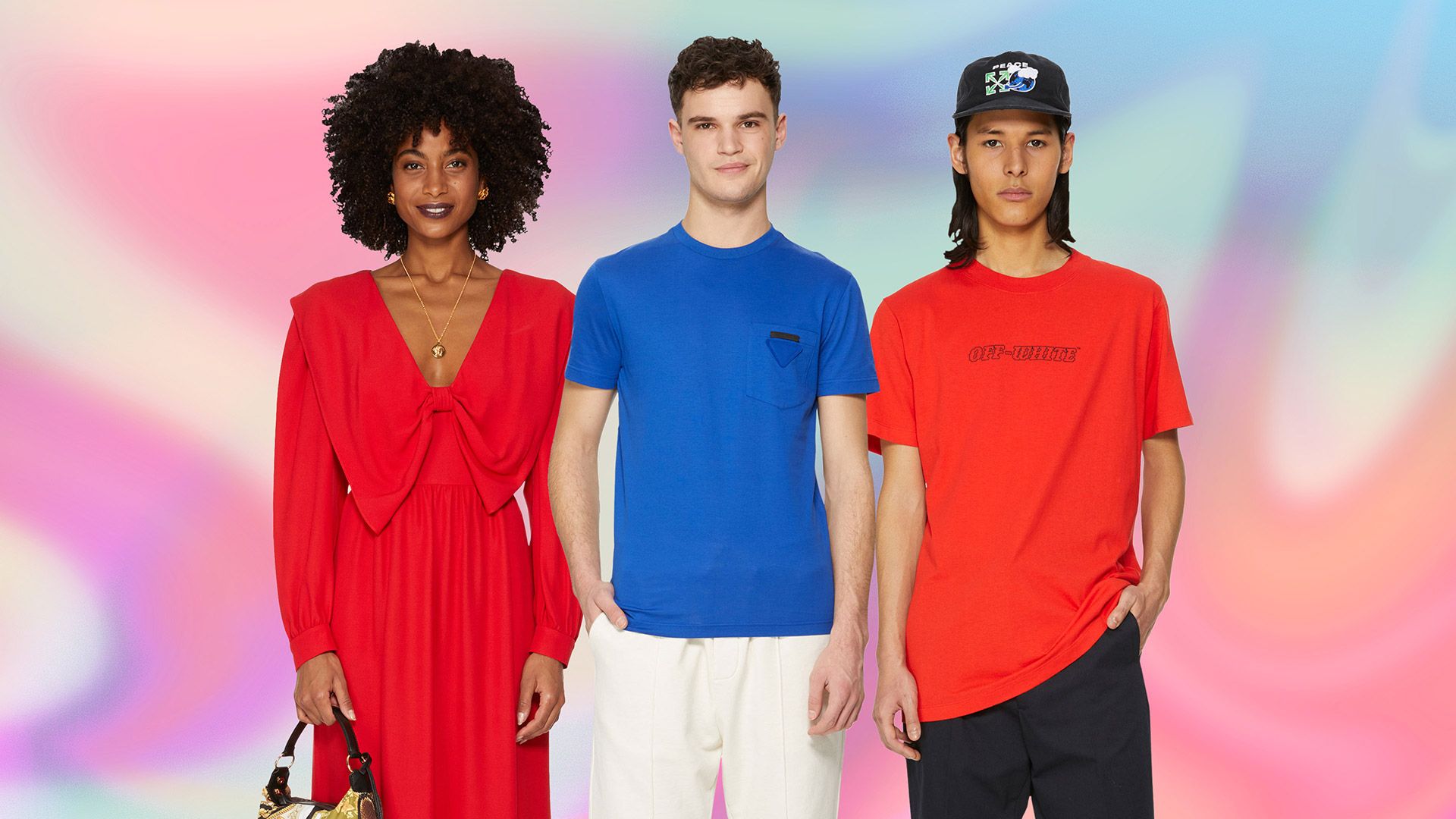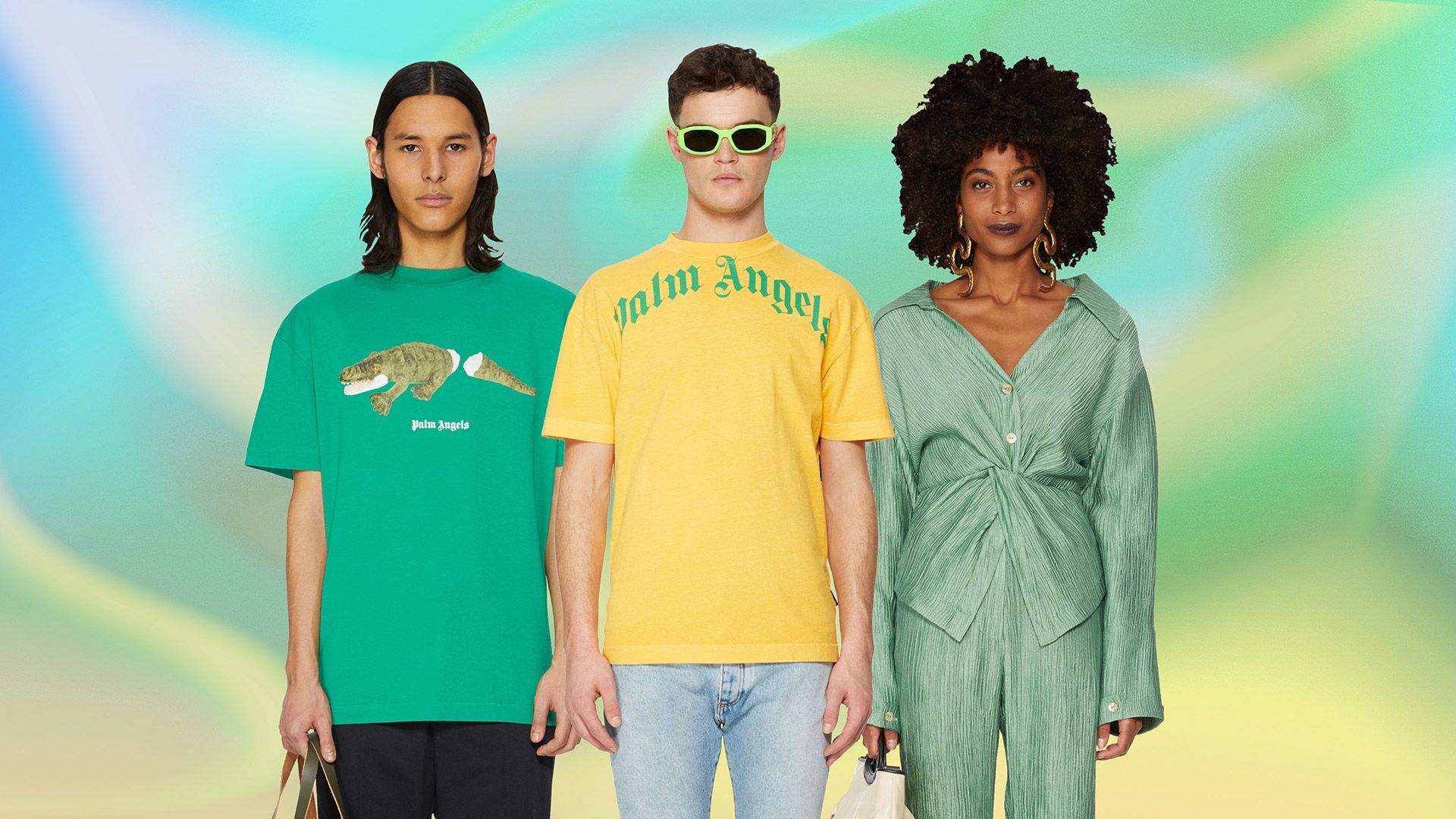-
What Clothes And Their Colors Tell Us About Our Times

Miu Miu satin maxi dress, Prada cotton T-shirt, Off-White cotton T-shirt.
There's nothing elementary about the symbolism of color and delving into it places us at the intersection of history, sociology, linguistics, science, art, technology, and, of course, fashion. If chromatic perception is first and foremost a physical phenomenon, culture is heavily invested here as well. Color sends us back to the image and sensation of light, but also to concepts themselves — ideas that we elaborate using one or several words. And as we all know, this is where things can get tricky. "The notion of color is deeply linked to the fact of its naming," explains Annie Mollard-Desfours, a linguist and semiologist at France's Centre National de Recherche Scientifique, and author of a series of chromatic lexicons. "Lacking a word that serves as a name, a given color cannot really be said to be distinguishable. Still today, certain populations don't make distinctions between certain colors." Hue is thus an ideological product whose interpretations vary. In this sense, it's a cultural phenomenon that's linked to a context, an era, and a given society. Often, the evolution and primacy of a color comes through its use in garments.
"The tints we wear are strong indicators of our place in the social world," Mollard-Desfours explains. For example, the progressive aims of hippies in the 1970s were accompanied by a recognizable dress-code characterized by warm, joyful shades, often juxtaposed with tie dye. Hues can also be markers of social class, as we see in idioms like "white collar" and "blue collar," the former pertaining to office work and the latter to manual labor or assembly-line employment.

Palm Angels logo T-shirt, Palm Angels yellow logo cotton T-shirt, Nanushka green Idris shirt.
Fashion phenomena in history
If classic dress-codes, especially in menswear, seem oriented towards neutral or even somber tones,
it
hasn't always been this way. In the early modern period (roughly the 16th to 19th century), people
wore
color proudly and regardless of gender. Varied tints symbolized light, joy, and even Salvation. Some
theories hold that Protestant reform contributed to profound changes in Western dress, as austerity
became the norm: "Protestant morals on color would be absorbed by capitalism and industrial society
itself, and leave traces into the 20th century," explains historian Michel Pastoureau in his essay
Les couleurs aussi ont une histoire, ("Colors have history too"), published in Mensuel
92. For this pigmentary expert, "Protestant chromoclasm," or the banishing of certain
colors,
would have a major influence on our current styles, marked as they are by the presence of white,
grey,
black, and navy
blue, "the black that doesn't speak its own name." It could even be at the base of a garment
emblematic
of our industrial societies, the famous blue jean — imported from the US and whose timeless,
gender-free
style has made it a wardrobe must. Understatement became synonymous with elegance, with black and
blue
dominating the collective imaginary and inspiring generations of creators. For over a century, blue
has
thus been the West's favorite color. Associated with security, comfort, and tenderness, it's
discreet
and doesn't cry for attention — unless, of course, it's a saturated cobalt.
When discussing colors, the idea of the gaze is essential. Wearing particular shades can signal a desire to be visible, to stand out or, on the contrary, to blend in with the crowd. Indeed, the history of socio-cultural paradigm shifts — of the struggles and victories to which fashion holds a mirror — is a saturated one. In the 60s, for example, the "Space Age" trend celebrated futuristic women via Courrèges' avant-garde chromatic schemes, where white was always the order of the day. "Encompassing a host of symbolic meanings, white is associated with the absolute, light, purity of both mind and body — but it also speaks to emptiness and silence, a free space where anything is possible," explains Annie Mollard-Desfours. Young people loved the looks, which seemed to emanate the glow of the second millennium long before its time. We also find this in silver, a hue still gracing catwalks sixty years later: streetwear-style at Lacoste, evanescent at Saint Laurent, or in crocodile at Loewe. The 80s, of course, brought with them a real color-bomb, with candied dyes and psychedelic combinations.

Sunspel cotton sweatshirt, Collina Strada blue satin tie-dye blouse, Bottega Veneta orange leather draped dress.
The powers of chromatics
Vibrant, flashy tints are making a comeback in a big way. Does their return signal a desire for
escape,
for some fresh air and fun? As much as color influences our mood, our behavior, and our psychology,
it
seems likely. While many studies on the question are too recent to have established any kind of
scientific law, neuroscientists are working on it. Wearing a garment of a given tone can indeed have
an
effect on our state of mind — meaning that it's an important aspect of how we see ourselves and,
naturally, how others see us. For Shakaila Forbes-Bell, creator and editor of The Psychology of
Fashion,
"the color of a piece of clothing reveals some of that person's psychosocial traits."
According
to the
fashion psychologist, who holds a degree from London College of Fashion, "clothes and the hues
we
wear
reflect our personality and our social status." In fact, it takes us less than a tenth of a
second to
form a first impression of someone we've just met thanks to a subconscious analysis. The tints we
choose
thus hold great power in hiding or affirming who we are. In 2008, Veronika Keller published a study
entitled "More than just a color: Pink as a gender and sexuality marker in visual communication," in
which she demonstrated how pink has overcome stereotypes associating it with girlishness to become a
symbol of independence, strength, and progress. As yesteryear's gender boundaries shift and become
transparent, pink is entirely at home in a unisex closet.
Colors adapt and evolve according to trends and seasons. Each spring, a new explosion of saturated garments arrives, pastel hues becoming progressively deeper as spring turns to summer and then fall, reminding us of bright green leaves and sun-bathed flowers. Mauve, formerly fashion's black sheep, is sported along with lavender tones in Jacquemus' Spring-Summer 2020 men's show, atop a fuchsia catwalk in the middle of nature. In 2019, color specialists Christine Foden and Tony Bannister anticipated nature-inspired tones would dominate 2020's Spring-Summer collections, from green to blue via orange and magenta. Last year, Pantone named "Classic Blue" the color of the year, presenting it as timeless, durable, and endowed with simple elegance. "Classic Blue" was meant to be calming, and to produce a "feeling of peace and tranquility." Indeed, the colors that we choose to wear reflect what we want in life. With the fashion world transitioning to more eco-friendly practices, we're also seeing the proliferation of "back-to-basics" trends in the interest of finding harmony with nature. No wonder, then, at the myriad nuances of green on this season's catwalks.
Color can't be underestimated — aesthetic, symbolic, psychological, and entrepreneurial — an entire industry is based around it today. It's also a field whose expansion never ceases to inspire, especially in neuroscience and technological innovation, where today over 300,000 distinct colors have been catalogued. The future is a palette of new and unexpected hues — providing loads of bright ideas and inexhaustible growth for today's hottest creators and designers.